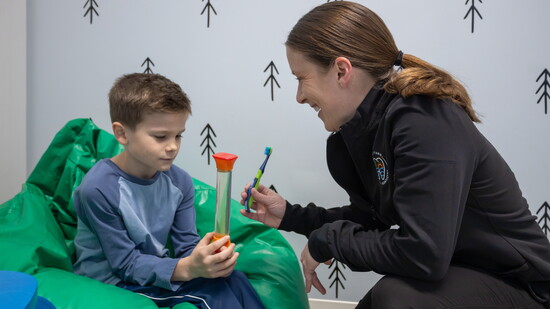Visiting the dentist can be a scary enough experience on its own, but it can be even more challenging for neurodivergent children who may have more sensory needs—something to keep in mind especially during April, which is Autism Awareness Month. In fact, Dr. Lauren Capozza at Loveland Pediatric Dentistry has focused her practice around just that—catering to (and caring for!) neurodivergent children and children with sensory needs.
Whether your kiddo has a diagnosis, will have one in the future, or maybe just has more sensory issues (particularly at dental appointments), Dr. Lauren and her team focus on helping young patients cope with dental procedures—all to stellar reviews.
“Heightened responses to different stimuli such as noises, lights, the feeling of things, touch … those are all ways kids can be neurodivergent—including in their communication of that,” Dr. Lauren explains. “Sometimes it can be hard to assess a child’s concern, so a key aspect is getting to know them and their family over time, trying different things, finding different areas we can focus on … the first visit may not provide all the answers, but we ask a lot of questions in the least threatening environment as possible.”
Dr. Lauren credits her staff of 8 for taking very detailed notes on all the methods they introduce in an appointment, how they were received, and suggestions for the next visit.
“We want to build on any small progress made—it teaches us more about that child,” she says. “I like to have seasoned people who are already dental experts, so we can focus on these other neuro aspects.”
But how does she do it? Dr. Lauren’s approach sets her practice (and check-ups!) apart.
Special Headphones
“We have noise-reducing headphones kids can wear … not necessarily needed for cleaning appointments, but usually when we’re using dental equipment or treatments with louder suction. And if a child has trouble with noise, we have a quieter area for them.”
Sensory Room
“Our sensory room for exams and cleanings doesn’t have a dental chair or a dental light—it just looks like a sitting room,” she explains. “Patients can sit on the couch or bean bags. We have sensory soothing toys they can hold, and dimmable lights we can reduce or turn off all the way if they like.” Dr. Lauren thinks of the sensory room as a stepping stone—by the time kids reach adulthood, hopefully they’ll be comfortable in a typical dental chair.
Weighted Blankets
“We use these a lot during treatments, because they provide a positive impact on the nervous system and the child’s mental state,” Dr. Lauren says. “We’ve had neurotypical children who are calmed by it as well—it helps them get snuggly and calm in the chair.”
Tinted Sunglasses
“Sunglasses can be really helpful, because artificial indoor lights can be very bright,” she continues. “Sunglasses can reduce the anxiety of having bright lights in their eyes.”
Beanbag Dental Chair
“Most dental chairs are adult-sized, so kids’ legs and such aren’t in the right spaces,” Dr. Lauren explains about the fit. “Having that extra space can make kids feel uncomfortable—some will wiggle when they start to get anxious, and we find it really helps them sit more still.”
PediatricDentistLoveland.com | 10570 Loveland Madeira Rd, Loveland | 513.806.2060
